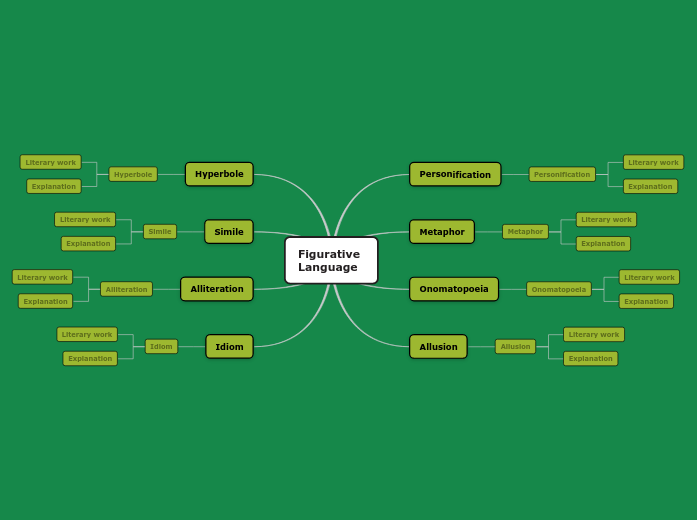Types of Figurative Language
Find figures of speech in your favorite novels and poems.
Keywords: writing, grammar, figurative language


Mere som dette
This template about figurative language will help you learn about each figure of speech: personification, simile, metaphor, onomatopoeia, allusion, idiom, alliteration, and hyperbole.
You will have to think about a literary work where you find each of them, give an example and explain your choice.
Use this template to learn the figurative language and think about examples for figures of speech so you can better understand each of them.
Find figures of speech in your favorite novels and poems.
Idiom is the figure of speech that uses a combination of words which challenges the conventional usage of those words.
What is the idiom that you found in the novel/poem?
Type it in.
Example: 'a stitch in time saves nine'.
How do you explain your choice? Type in the explanation.
Example:
- A timely effort saves you from much harder work later.
What is the literary work in which you found the idiom? What genre is it?
Example: Pie-IX: A Stitch in Time Saves Nine by Jaida Jones, K.J. Sturgeon - short story.
How do you explain your choice?
Example:
- Almost all the words in the sentence begin with 'th'.
What is the literary work
in which you found the alliteration? Type in the genre.
Example: Thank You for the Thistle by Dorie Thurston - short story.
Simile is a figure of speech that compares two objects through some connective word such as 'like', 'as', 'so', 'than', or a verb such as 'resembles'.
What simile did you find in the novel/poem? Type it in.
Example:
- 'Within the irregular arc of coral the lagoon was still as a mountain lake.'
How do you explain your choice?
Type in the explanation. Example:
- The lagoon is being compared with a mountain lake using the word 'as'.
What is the literary work in which you found the simile?
Is it a novel, short story or poem?
Example: Lord of the flies by William Golding - novel.
The hyperbole is a figure of speech that uses exaggerations to create emphasis or effect.
What hyperbole did you find in the novel/poem? Type it in.
Example:
- 'All that we see or seem / Is but a dream within a dream.'
How do you explain your choice?
Type in the explanation.
Example:
- It is an exaggeration to claim that everything ('all we see or seem') is 'but a dream'.
What is the literary work in which you found the hyperbole? Is it a novel, short story or poem?
Example: A dream within a dream by Edgar Allan Poe - poem.
Allusion is the figure of speech that makes a reference to a well-known person, place, or thing in literature and history.
What is the allusion that you found in the novel/poem? Type it in.
Example:
- 'Like a rich jewel in an Ethiop's ear'.
How do you explain your choice?
Example:
- Shakespeare makes an allusion of the Ethiopian slaves who wore expensive jewelry to express their masters' wealth.
What is the literary work in which you found the allusion? What genre is it?
Example: Romeo and Juliet by William Shakespeare - tragedy
Onomatopoeia is the figure of speech that uses words whose sounds suggest their meanings. Think of words related to water, air, collisions, sounds, voice, etc.
What is the onomatopoeia that you found in the novel/poem? Type it in.
Example:
'The moan of doves in immemorial elms,
And murmuring of innumerable bees...'.
How do you explain your choice?
Example:
'Moan' and 'murmuring' refer to the way doves and bees sound like.
What is the literary work in which you found the onomatopoeia? Is it a novel, short story or poem?
Example: Come Down, O Maid by Alfred Lord Tennyson - poem
Metaphor is a figure of speech that compares two unlike things without using 'like' or 'as'.
What is the metaphor that you found in the novel/poem? Type it in.
Example:
'The rain came down in long knitting needles.'
How do you explain your choice?
Example:
The rain is compared with 'long knitting needles', without the use of 'like' or 'as'.
What is the literary work in which you found the metaphor? Is it a novel, short story or poem?
Example:
National Velvet by Enid Bagnold - novel.
Personification is a figure of speech which gives human qualities to nonhuman things.
Type in the personification you found in the novel/poem.
Example:
'- Not to-night, good Iago: I have very poor and unhappy brains for drinking.'
How do you explain your choice?
Type in the explanation.
Example:
The brain is given the attribute of being 'unhappy'.
What is the literary work in which you found the personification? What is its genre?
Example:
Othello by William Shakespeare - tragedy
Mind maps hjælper dig med at brainstorme, etablere relationer mellem begreber, organisere og generere ideer.
Mind map-skabeloner er dog en nemmere måde at komme i gang på, da de er rammer, der indeholder information om et specifikt emne med vejledende instruktioner. I bund og grund sikrer mind map-skabeloner den struktur, der kombinerer alle elementerne i et specifikt emne og fungerer som udgangspunkt for dit personlige mind map. De er en ressource, der giver en praktisk løsning til at lave et mind map om et bestemt emne, enten til erhverv eller uddannelse.
Mindomo giver dig smarte mind map-skabeloner, der gør det muligt for dig at fungere og tænke ubesværet.
Beskrivende emner
Emner med baggrundstekst
Standard-gren
Fjernelse af skabelondata
Du kan vælge mellem en række mind map-skabeloner fra Mindomos erhvervs- eller uddannelseskonti, eller du kan lave dine egne mind map-skabeloner fra bunden. Ethvert mind map kan omdannes til et mind map-skabelon-map ved at tilføje yderligere vejledende noter til et af emnerne.